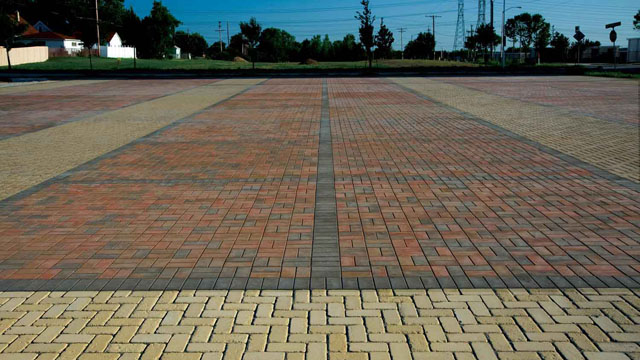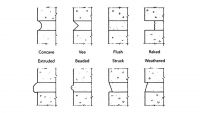December 28, 2011 12:35 PM CST
Completed this summer, the farmer’s market really began three years ago, when Bryan Simon, owner of Simon Landscape Co. Inc., started Energy Exchange. The nonprofit educates the public about rainwater management and other green topics. Simon’s vision included transforming a one-mile stretch of vacant or decaying spaces into a showcase of better management techniques in a city prone to overflowing storm sewers.
An alderman championed Simon’s idea and expanded it with a resolution to create a 3.5-mile Green Corridor. Water-friendly upgrades, including permeable paving and bioswales, are popping up along the corridor, which also will serve as a testing ground for green technologies such as solar-powered signage and LED lighting.
Simon’s own on-the-ground efforts started with a community garden on one end of the corridor with an adjacent farmer’s market. The farmer’s market features 66 10- X 10-foot stalls created using CalStar pavers in the autumn blend, laid in a basketweave pattern. Each booth is bordered by an eight-inch, dark gray soldier course. CalStar pavers in the tumbled natural color, arranged in a 90-degree herringbone pattern, create the eight-foot-wide aisles. Finally, the entire plaza is ringed by another dark gray soldier course.
“I was looking for a way to make our farmer’s market unique and attract vendors and people,” says Simon of his decision to make the pavers an integral part of the design. The booth layouts forgo any jockeying for position by vendors, provide clear delineation for patrons and provide aesthetic interest even when the vast space is not in use.
It took a crew of eight to 10 installers three weeks to place the nearly 65,000 pavers. In keeping with the corridor’s water management goals, all water that falls on the plaza remains. The space is designed to direct water flow to one end, where it is captured and stored. In the future, the water will be recirculated through a planned water feature and also pumped for use in the community garden.
For the vehicular loading area, still under construction at the east end, Simon plans to install a four-foot strip of CalStar permeable pavers sandwiched between two, three-foot concrete bands.
The market, which also can be used for other community and private events, will connect to the garden via brick walkways that will meander through a plaza-wide pergola.
Along with aesthetics, the CalStar pavers add to the Corridor’s sustainability story. The pavers are made using CalStar’s proprietary manufacturing process that incorporates 40 percent local recycled material (fly ash, a byproduct from power plants) as the binder, which avoids the energy-intensive kiln firing required for clay pavers and the use of Portland cement contained in concrete pavers. This results in 85 percent less carbon emitted, and up to 85 percent less energy used for manufacturing. For this project, the manufacturer calculates that using 64,935 CalStar pavers, instead of traditional clay or concrete pavers, prevented nearly 25 tons of CO2 from being emitted, saved 32.5 million BTU of energy, and diverted 69 tons of waste from the landfill.
Milwaukee Green Corridor Farmer’s Market
Farmer’s Market Plaza and Green Corridor bring rainwater management to Milwaukee
By Masonry

CalStar pavers add to the Corridor’s sustainability story.
Functionally, the new 11,000-square-foot plaza in Milwaukee’s Garden District serves as a farmer’s market. Symbolically, it’s the beginning of a much larger green movement in an evolving section of the city.Completed this summer, the farmer’s market really began three years ago, when Bryan Simon, owner of Simon Landscape Co. Inc., started Energy Exchange. The nonprofit educates the public about rainwater management and other green topics. Simon’s vision included transforming a one-mile stretch of vacant or decaying spaces into a showcase of better management techniques in a city prone to overflowing storm sewers.
An alderman championed Simon’s idea and expanded it with a resolution to create a 3.5-mile Green Corridor. Water-friendly upgrades, including permeable paving and bioswales, are popping up along the corridor, which also will serve as a testing ground for green technologies such as solar-powered signage and LED lighting.
Simon’s own on-the-ground efforts started with a community garden on one end of the corridor with an adjacent farmer’s market. The farmer’s market features 66 10- X 10-foot stalls created using CalStar pavers in the autumn blend, laid in a basketweave pattern. Each booth is bordered by an eight-inch, dark gray soldier course. CalStar pavers in the tumbled natural color, arranged in a 90-degree herringbone pattern, create the eight-foot-wide aisles. Finally, the entire plaza is ringed by another dark gray soldier course.
“I was looking for a way to make our farmer’s market unique and attract vendors and people,” says Simon of his decision to make the pavers an integral part of the design. The booth layouts forgo any jockeying for position by vendors, provide clear delineation for patrons and provide aesthetic interest even when the vast space is not in use.
It took a crew of eight to 10 installers three weeks to place the nearly 65,000 pavers. In keeping with the corridor’s water management goals, all water that falls on the plaza remains. The space is designed to direct water flow to one end, where it is captured and stored. In the future, the water will be recirculated through a planned water feature and also pumped for use in the community garden.
For the vehicular loading area, still under construction at the east end, Simon plans to install a four-foot strip of CalStar permeable pavers sandwiched between two, three-foot concrete bands.
The market, which also can be used for other community and private events, will connect to the garden via brick walkways that will meander through a plaza-wide pergola.
Along with aesthetics, the CalStar pavers add to the Corridor’s sustainability story. The pavers are made using CalStar’s proprietary manufacturing process that incorporates 40 percent local recycled material (fly ash, a byproduct from power plants) as the binder, which avoids the energy-intensive kiln firing required for clay pavers and the use of Portland cement contained in concrete pavers. This results in 85 percent less carbon emitted, and up to 85 percent less energy used for manufacturing. For this project, the manufacturer calculates that using 64,935 CalStar pavers, instead of traditional clay or concrete pavers, prevented nearly 25 tons of CO2 from being emitted, saved 32.5 million BTU of energy, and diverted 69 tons of waste from the landfill.
Originally published in Masonry magazine.
About the Author
Masonry, the official publication of the Mason Contractors Association of America, covers every aspect of the mason contractor profession - equipment and techniques, building codes and standards, business planning, promoting your business, legal issues and more. Read or subscribe to Masonry magazine at www.masonrymagazine.com.


















